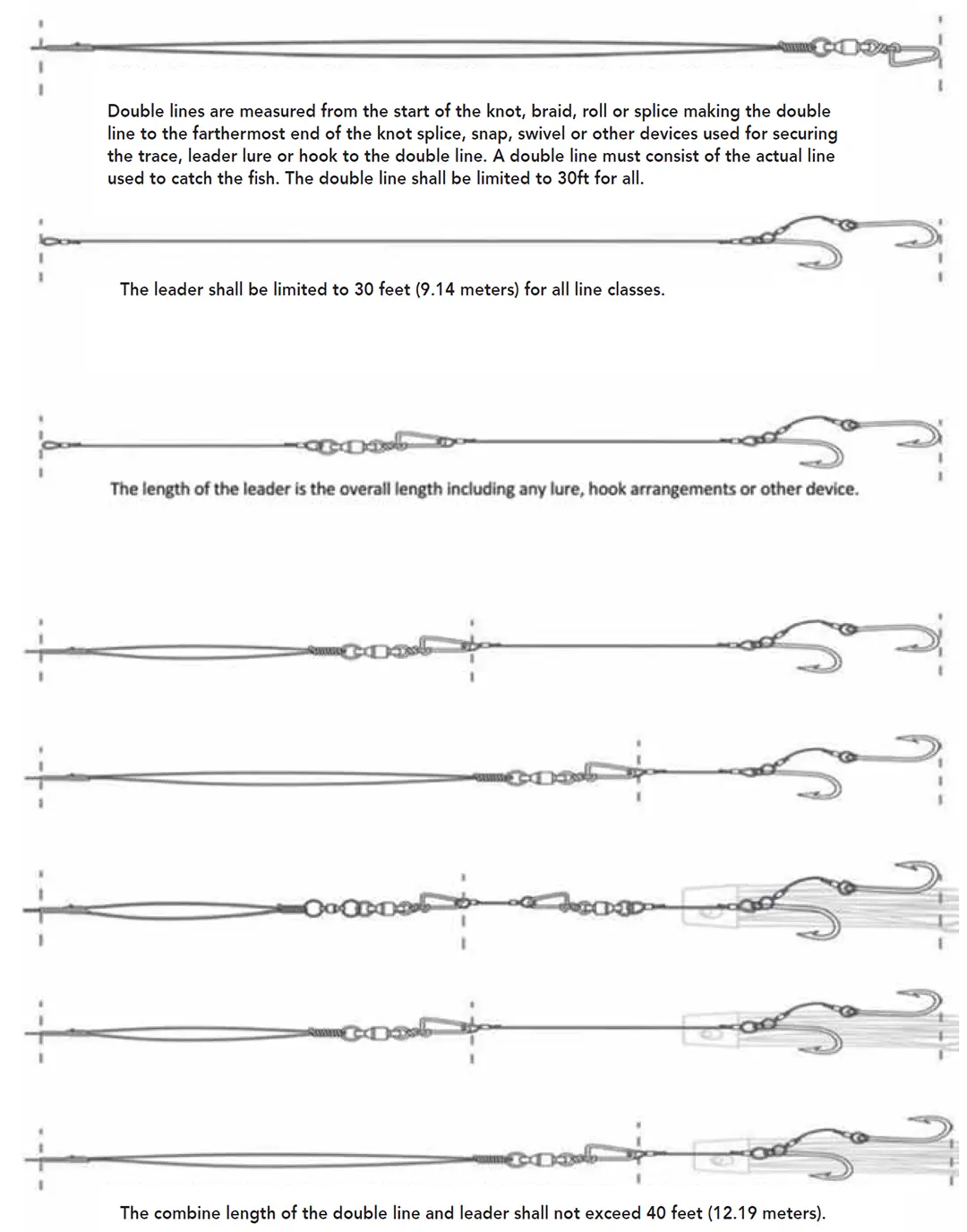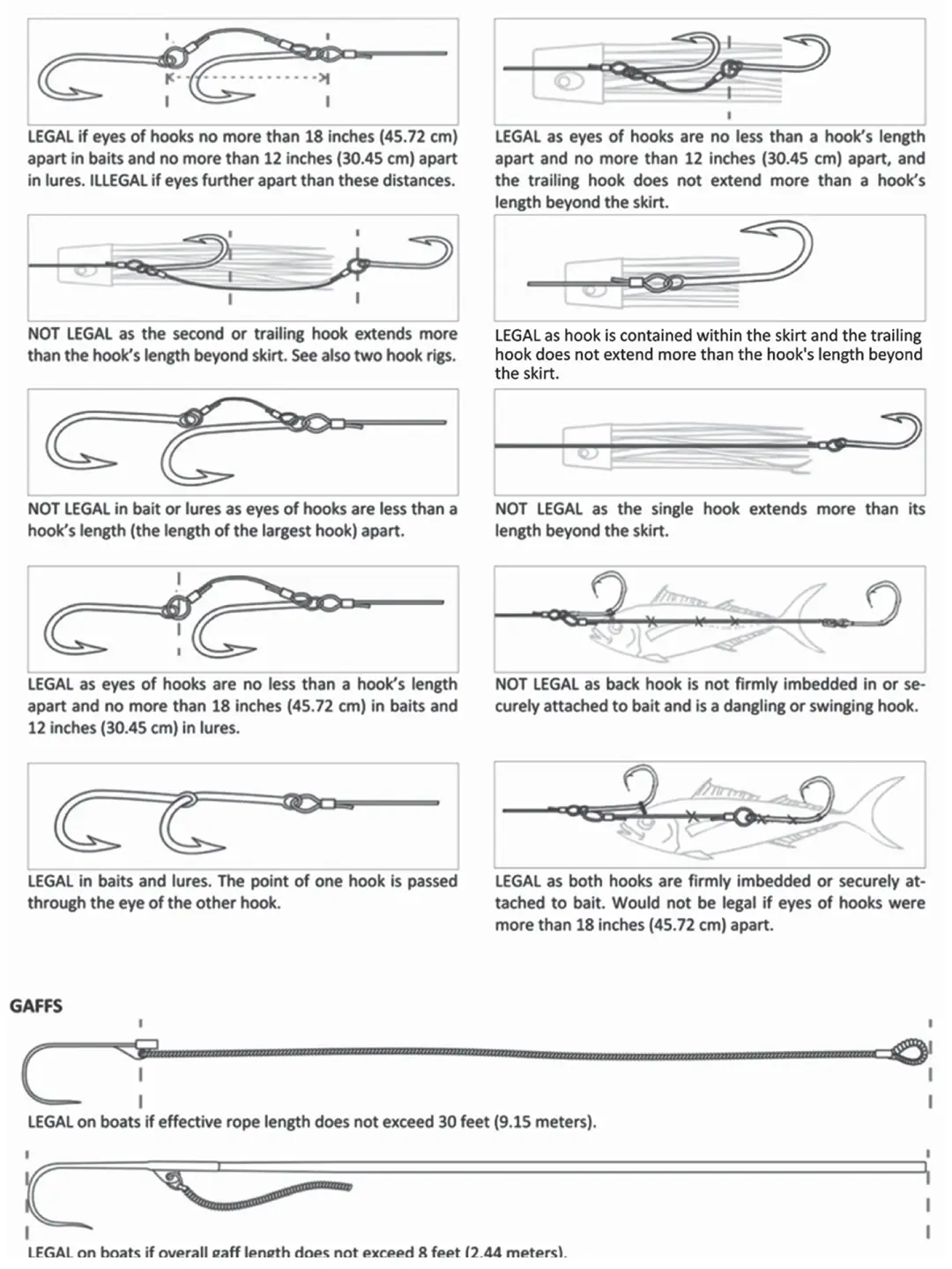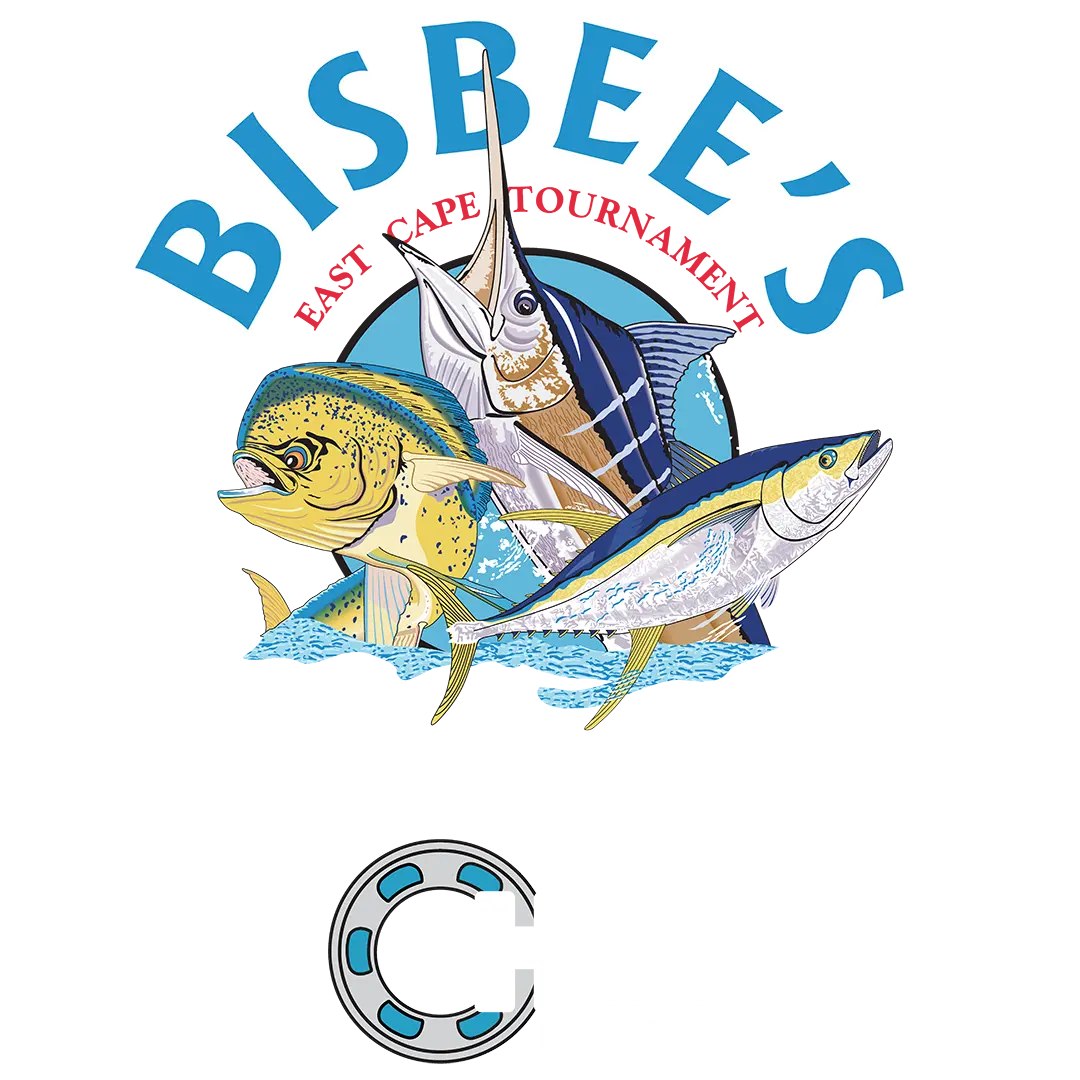Equipment Rules
Official equipment regulations for all Bisbee's tournaments. Please review these rules carefully to ensure compliance. Key resources are available for download below.
Official Tackle Diagrams


Equipment Rules
- Fishing Line & Backing
- a) The term “Backing” pertains to any line on the reel that precedes the “Fishing Line” whether connected to the fishing line or not. The use of backing is permissible and does not have a maximum strength limit.
The term “Fishing Line” pertains to the first 16.5 feet (5 meters) of line directly preceding the double line, leader, or hook. This section of fishing line must be comprised of a single, homogenous piece of line, and have a “Manufacturer’s Stated” maximum breaking strength of 130 lbs. or less. The catch shall be classified under the breaking strength of the Fishing Line and must be a minimum length of the stated 16.5 feet (5 meters). Dacron, monofilament, multifilament, and lead core multifilament lines may be used on either. Line by the trade name of Spectra is acceptable. Wire lines are prohibited. - b) There are no regulations regarding the material or strength of the leader.
- c) The leader on all classes of tackle shall be limited to 30 feet. The combined length of the double line and leader shall be limited to 40 feet.
- a) The term “Backing” pertains to any line on the reel that precedes the “Fishing Line” whether connected to the fishing line or not. The use of backing is permissible and does not have a maximum strength limit.
- Double Line
The use of a double line is not required. If one is used, it must meet the following specifications:- a) A double line must consist of the actual Fishing Line used to catch the fish.
- b) Double lines are measured from the start of the knot, braid, roll or splice making the double line to the farthermost end of the knot, splice, snap, swivel or other device used for securing the trace, leader, lure or hook to the double line.
- c) The double line on all classes of tackle shall be limited to 30 feet. The maximum combined length of the double line and leader is 40 feet.
- Leader
The use of a leader is not required. If one is used, it must meet the following specifications:- a) The length of the leader is the overall length including any lure, hook arrangement or other device and is measured to the bend of the last hook.
- b) The leader must be connected to the line with a snap, knot, splice, swivel or other device.
- c) There are no regulations regarding the material or strength of the leader.
- d) The leader on all classes of tackle shall be limited to 30 feet. The combined length of the double line and leader shall be limited to 40 feet.
- Rod
- a) Rods must comply with sporting ethics and customs.
- b) The rod tip must be a minimum of 40 inches in length. The rod butt cannot exceed 27 inches.
- c) These measurements must be made from a point directly beneath the center of the reel. A curved butt is measured in a straight line.
- Reel
- a) Reels must comply with sporting ethics and customs.
- b) Power driven reels of any kind are prohibited. This includes motor, hydraulic, or electrically driven reels, and any device which gives the angler an unfair advantage.
- c) Ratchet handle reels are prohibited.
- d) Reels designed to be cranked with both hands at the same time are prohibited.
- Hooks-Natural Bait (Live or Dead)
- a) Any hook used with natural baits, live or dead, must be a non-offset circle hook.
- b) No more than two single hooks may be used. Both must be firmly imbedded in or securely attached to the bait. The eyes of the hooks must be no less than a hook's length (the length of the largest hook used) apart and no more than 18 inches apart. The only exception is that the point of one hook may be passed through the eye of the other hook.
- c) A hook may not precede the bait, or bait/lure combo by more than one hook's length.
- d) The use of a dangling/swinging hook is prohibited. No double or treble hooks.
- Hooks - Artificial Lures
- a) When using an artificial lure with a skirt or trailing material, no more than two single hooks may be attached to the line, leader, or trace. The eyes of the hooks must be no less than an overall hook's length (the overall length of the largest hook used) apart and no more than 12 inches apart. The only exception is that the point of one hook may be passed through the eye of the other hook. The trailing hook may not extend more than a hook's length beyond the skirt of the lure.
- b) A hook may not precede the lure or bait/lure combo by more than one hook's length.
- c) The tournament recognizes products produced by Quick Rig Corporation under the trade name "Double Trouble Hooks" as acceptable tackle to be used in the tournament.
- Drones
Drones are not permitted to be flown during fishing hours. Special exceptions may be granted for promotional purposes only. - Other Equipment
- a) Fighting chairs may not have any mechanically propelled devices that aid the angler in fighting.
- b) Gimbals must be free swinging. Gimbals that allow anglers to reduce strain or rest while fighting the fish are prohibited.
- c) Harnesses may be attached to the reel or rod, but not to the fighting chair. The harness may be replaced or adjusted by a person other than the angler.
- d) Rod belts or waist gimbals are permitted.
- e) Gaffs used to boat a fish must not exceed 8 feet in overall length. In using a flying or detachable gaff the rope may not exceed 30 feet. The gaff rope is measured from the point where it is secured to the detachable head to the other end. If a fixed head gaff is used, the same limitations shall apply and the gaff rope shall be measured from the same location on the gaff hook. Only a single hook is permitted on any gaff. Harpoon or lance attachments are prohibited. Tail ropes are limited to 30 feet.
- f) Entangling devices, with or without a hook, are prohibited and may not be used for any purpose including baiting, hooking or fighting or landing the fish.
- g) Nets may not be used to obtain a fish.
- h) Outriggers, downriggers, spreader bars and kites are permitted to be used, provided that the actual fishing line is attached to a snap or other release device, either directly or with some other material. The leader or double line may not be connected to the release mechanism either directly or with the use of a connecting device. Spreader bars are also acceptable when used strictly as a teaser.
- i) Daisy chains, birds, floats and similar devices may only be used if they do not unfairly hamper or inhibit the normal swimming or fighting ability of the fish, thereby giving the team an unfair advantage in fighting, releasing or boating the fish. Acceptability of this equipment will be determined by the Tournament Organizers on an individual, as needed basis.
- j) A safety line may be attached to the rod provided it does not in any way assist the angler in fighting the fish.
Reglas de Equipo
- LINEA DE PESCA Y APOYO
- a) El término "Backing" APOYO, se refiere a cualquier línea en el carrete ANTES de la "línea de pesca", conectada o no a la línea. El uso de Backing está permitido y no tiene límite de Resistencia.
- b) El término "Línea de Pesca" se refiere a los primeros 16.5 pies (5 metros) de línea directamente antes de la doble línea, leader y anzuelos esta sección de la línea de pesca debe ser una línea homogénea y tener una resistencia "establecida "e por el fabricante" de 130 libras máximo, o menor. La captura deberá clasificarse bajo la Resistencia establecida de la" línea de pesca" y será de un largo mínimo de 16.5 pies (5 metros). Dacrón, monofilamento, multifilamento y multilíneas con centro de plomo, podrán utilizarse en ambos casos. La línea Spectra es aceptable, las líneas de alambre están prohibidas.
- Doble línea
El uso de una doble línea no es obligatorio, pero si se usa debe cumplir con las siguientes especificaciones:- a) Una doble línea debe consistir en la misma utilizada en la "línea de pesca" para atrapar al pez.
- b) La doble línea se mide a partir del nudo, destorcedor o unión de la "línea de pesca" hasta el leader, que a su vez une el curricán, señuelo y anzuelos.
- c) La doble línea, en todas las combinaciones tiene un límite de 30 pies. El largo máximo combinado, de doble línea y leader no excederá de 40 pies.
- Leader
El uso de leader no es requerido, pero si se utiliza, debe cumplir con estas especificaciones:- a) la longitud total del leader, incluyendo curricán y arreglo de anzuelos, se mide a partir del empate del leader y hasta la base del ultimo anzuelo.
- b) El leader se conectará a la línea con un destorcedor, nudo, seguro u otro método.
- c) se prohíben artículos de sujeción.
- d) No hay regulación sobre el material y resistencia del Leader.
- e) El leader en todas las clases de arreglos, deberá limitarse a 30 pies, no olvidar que la combinación de leader y doble línea no podrá sobrepasar los 40 pies.
- Caña
- a) Las cañas deben cumplir con la costumbre y ética deportiva.
- b) La punta de la caña no podrá exceder de 40 pulgadas, el mango no excederá de 27 pulgadas.
- c) Estas medidas son consideradas de un punto al centro de la caña. El mango curvo se mide en línea recta.
- Carrete
- a) Los carretes cumplirán con las normas y ética de la pesca deportiva.
- b) Están prohibidos los carretes motorizados de cualquier clase. Incluidos los eléctricos e hidráulicos, así como cualquier artefacto que otorgue una ventaja al pescador.
- c) Carretes de matraca, están prohibidos.
- d) Carretes diseñados para ser manejados con ambas manos, están prohibidos.
- Anzuelos para carnada natural, viva o muerta.
- a) Anzuelos utilizados con carnada natural, viva o muerta deben ser circulares.
- b) No deberán usarse más de dos anzuelos individuales dentro de o firmemente sujetos a la carnada. Los ojos de los anzuelos no deberán estar separados, por una distancia mayor al largo de los anzuelos. (la distancia del anzuelo más largo, utilizado) y separados por no más de 18 pulgadas. La única excepción es que un anzuelo esté conectado al otro por el ojo.
- c) El anzuelo no debe preceder a la carnada o combinación de carnada/ señuelo por más de un largo de anzuelo.
- d) Anzuelos sueltos o bailarines están prohibidos. No anzuelos con doble o triple gancho.
- Anzuelos para curricán o señuelo
- a) Cuando se use carnada artificial (curricán) con falda o greña, no se usarán más de dos anzuelos unidos al leader. Los anzuelos no deberán estar separados, los ojos de los anzuelos no podrán estar separados por más del largo del mayor de ellos. La excepción es; pasar un anzuelo por el ojo del otro. Ningún anzuelo deberá sobresalir completo de la falda del curricán.
- b) Ningún anzuelo podrá ir antes de la carnada o de la combinación Carnada/ señuelo, por más de un largo de anzuelo.
- c) El torneo reconoce que los productos elaborados por la compañía Quick Rig bajo el nombre comercial de "Double Trouble Hooks" son aceptables.
- Drones
NO se permite el vuelo de drones durante las horas de pesca, se podrán hacer excepciones para propósitos de promoción. - Otro Equipo
- a) Las sillas de pelea, no podrán tener ningún aditamento mecánico, que pueda ayudar al pescador en la pelea.
- b) Los tinteros deberán girar libremente, está prohibido utilizar tinteros que restrinjan el manejo de la caña y concedan una ventaja al pescador.
- c) Se podrán colocar arneses o "snaps" a las cañas, pero no a las sillas de pelea. Los que podrán ser ajustados por otra persona y/o el pescador.
- d) Cinturones o tinteros de cinturón, están permitidos, al pelear de pie.
- e) Los ganchos para subir al pescado, no deben exceder de 8 pies de largo total. Caso de utilizar gancho volador o separable, la cuerda no podrá exceder 30 pies. La cuerda se mide desde la unión al gancho hasta el nudo final. Si se utiliza un gancho fijo con cuerda, aplican las mismas restricciones; 30 pies medidos desde la misma ubicación del gancho. Arpón y/o lanzas quedan prohibidos.
- f) Se prohíbe el uso de materiales y artefactos que impidan el libre nado de los peces objeto, así como cebarlos y/o llevarlos a aguas poco profundas.
- g) Absolutamente se prohíbe el uso de redes, para capturar un ejemplar.
- h) Outriggers, downriggers, barras espaciadoras y papalotes son permitidos, siempre y cuando, la línea de pesca se sujete a un snap o cualquier material que le permita zafarse. Leader y doble línea no podrán sujetarse al mecanismo de sujeción, ya sea en forma directa o con otra línea, Las barras espaciadoras, se permiten únicamente como señuelos (teaser).
- i) Daisy chains, pajaritos, boyas y objetos similares, podrán ser utilizados, siempre y cuando no inhiban o reducan la capacidad de nadar y pelear de los peces objetivo, otorgando una ventaja desleal a los pescadores, ya sea para liberar o atraparlos. La aceptación de estos objetos será determinada por el comité organizador en base a cada solicitud.
- j) Una línea de seguridad podrá atarse a la caña, sin que ayude al pescador, solo para asegurarse de no perderla.
